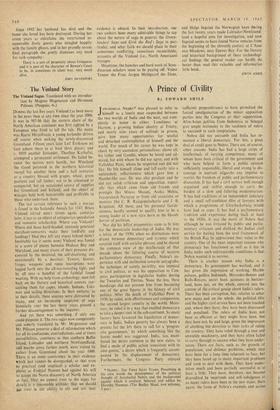The Vinland Story
The Vinland Sagas. Translated with an introduc- tion by Magnus Magnusson and Hermann Palsson. (Penguin, 4s.) DURING the last five years Vinland has been more in the news than at any time since the year 1000. It was in 985-86 that the eastern shore of the North American continent was first sighted by a European who lived to tell the tale. His name was Bjarni Herjolfsson, a young Icelander driven off course when seeking the newly-discovered Greenland. Fifteen years later Leif Eiriksson set foot ashore there in at least three places; and c. 1010 another Icelander, Thorfinn Karlsefni, attempted a permanent settlement. He failed be- cause the natives were hostile, but Wineland the Good persisted in the northern historical record for another three and a half centuries as a country blessed with grapes, wheat, green pastures and tall timber, not to be colonised or conquered, but an occasional source of supplies for Greenland and Iceland, and the object of voyages held both honourable and profitable to those who' undertook them.
The last certain reference to such a voyage is found in the Icelandic Annals for 1347. When Vinland stirred men's minds again, centuries later, it was as an object of antiquarian speculation and romantic scholarship. Where was Vinland? Where did those hard-headed. intensely practical merchant-venturers make their landfalls and landings? Had they left any traces behind them? Inevitably (so it seems now) Vinland was found in a score of places between Hudson Bay and Maryland, and many traces of their presence dis- covered by the deceived, the self-deceiving, and occasionally by a deceiver. Towers, houses, forges, weapons and runic inscriptions were lugged forth into the all-too-revealing light, and by all save a handful of the faithful found wanting. With no help from archeology, men fell back on the literary and historical sources, ran- sacking them for capes, islands, Indians, Eski- mos and sailing directions. In their entirety, as in their details, these sources were distrusted by many, and an increasing suspicion of saga historicity over the last thirty years proved a further-discouragement to the inquirer.
And yet there was something, if only one could pinpoint it. The two sagas now competently and soberly translated by Mr. Magnusson and Mr. Palsson preserve a deal of information which for all its confusions, contradictions, and at times incredibilities, convinces us that southern Baflin Island, Labrador and northern Newfoundland, and maybe areas farther south, were visited by sailors from Greenland about the year 1000. There is an inner consistency in their evidence which just cannot be disregarded, so that even so practical (and sceptical) a scholar and ex- plorer as Fridtjof Nansen had against his will to accept the Norse discovery of North America as fact. That we cannot trust to the sagas for details is a reasonable attitude; that we should riot trust in our ability to sift and test their evidence is absurd. In their intrcduction, our two authors have many admirable things to say about the nature of saga in general, the Green- landers' Saga and Eirik the Red's Saga in par- ticular, and what faith we should place in their sometimes conflicting, sometimes reconcilable, accounts of the Vinland (i.e., North American) voyages.
Meantime, the hunches and hard work of Scan- dinavian scholars seem to be paying off. Vaino Tanner the Finn, Jorgen Meldgaard the Dane,
and Helge Ingstad the Norwegian have during the last twenty years made Labrador-Newfound- land a hopeful area for investigation, and now Ingstad seems to have found Norse remains from the beginning of the eleventh century at L'Anse aux Meadows, near t paves Bay. Fot the literary and historical background of these archwologi- cal findings the general reader can hardly do better than read this valuable and informative little book.
GWYN JONES


































 Previous page
Previous page